Comprehensive Evaluation of Green Development in Dongliao River Basin from the Integration System of “Multi-Dimensions”
Abstract
:1. Introduction
2. Materials and Methods
2.1. Study Area
2.2. Data Sources
2.3. Methodology Framework
2.3.1. System Dynamics Model (SD Model)
2.3.2. Weight Determination
2.3.3. Delineation of Production–Living–Ecological Space
2.3.4. Construction of Coupling Coordination Degree Model
2.3.5. Moran’s Index
3. Results
3.1. Construction of the SD Model for Regional REECC
3.2. Construction of A REECC Evaluation Index System
3.3. Spatial Distribution of REECC, PLES, and ER
3.4. Comprehensive Index of Green Development of Resources, Environment, and Ecosystem in DRB
4. Discussion
5. Conclusions
Author Contributions
Funding
Acknowledgments
Conflicts of Interest
References
- Sun, C.; Tong, Y.; Zou, W. The evolution and a temporal-spatial difference analysis of green development in China. Sustain. Cities Soc. 2018, 41, 52–61. [Google Scholar] [CrossRef]
- Fang, G.; Wang, Q.; Tian, L. Green development of Yangtze River Delta in China under Population-Resources-Environment-Development-Satisfaction perspective. Sci. Total Envion. 2020, 727, 138710. [Google Scholar] [CrossRef]
- Shaker, R.R. The spatial distribution of development in Europe and its underlying sustainability correlations. Appl. Geogr. 2015, 63, 304–314. [Google Scholar] [CrossRef]
- Shaker, R.R.; Zubalsky, S.L. Examining patterns of sustainability across Europe: A multivariate and spatial assessment of 25 composite indices. Int. J. Sustain. Dev. World Ecol. 2015, 22, 1–13. [Google Scholar] [CrossRef]
- Belmonte-Ureña, L.J.; Plaza-Úbeda, J.A.; Vazquez-Brust, D.; Yakovleva, N. Circular economy, degrowth and green growth as pathways for research on sustainable development goals: A global analysis and future agenda. Ecol. Econ. 2021, 185, 107050. [Google Scholar] [CrossRef]
- Skea, J.I.M.; Nishioka, S. Policies and practices for a low-carbon society. Clim. Policy 2008, 8, S5–S16. [Google Scholar] [CrossRef]
- Wang, Y.; Li, H.; Yu, H. Analysis of spatial pattern and evolution characteristics of provincial green development in China. China Popul. Resour. Environ. 2018, 28, 96–104. [Google Scholar]
- Caiado, R.G.G.; de Freitas Dias, R.; Mattos, L.V.; Quelhas, O.L.G.; Leal Filho, W. Towards sustainable development through the perspective of eco-efficiency—A systematic literature review. J. Clean. Prod. 2017, 165, 890–904. [Google Scholar] [CrossRef] [Green Version]
- Turner, R.K. BLUEPRINT FOR A GREEN ECONOMY. Environment 1990, 32, 25–26. [Google Scholar] [CrossRef]
- Rashidi, K.; Saen, R.F. Measuring eco-efficiency based on green indicators and potentials in energy saving and undesirable output abatement. Energy Econ. 2015, 50, 18–26. [Google Scholar] [CrossRef]
- Luukkanen, J.; Kaivo-Oja, J.; Vahakari, N.; O’Mahony, T.; Korkeakoski, M.; Panula-Ontto, J.; Phonhalath, K.; Nanthavong, K.; Reincke, K.; Vehmas, J.; et al. Green economic development in Lao PDR: A sustainability window analysis of Green Growth Productivity and the Efficiency Gap. J. Clean. Prod. 2019, 211, 818–829. [Google Scholar] [CrossRef]
- Merino-Saum, A.; Baldi, M.G.; Gunderson, I.; Oberle, B. Articulating natural resources and sustainable development goals through green economy indicators: A systematic analysis. Resour. Conserv. Recycl. 2018, 139, 90–103. [Google Scholar] [CrossRef]
- Mickwitz, P.; Melanen, M.; Rosenstrom, U.; Seppala, J. Regional eco-efficiency indicators-a participatory approach. J. Clean. Prod. 2006, 14, 1603–1611. [Google Scholar] [CrossRef]
- Zhang, J.; Zhang, K.; Zhao, F. Research on the regional spatial effects of green development and environmental governance in China based on a spatial autocorrelation model. Struct. Chang. Econ. Dyn. 2020, 55, 1–11. [Google Scholar] [CrossRef]
- Dijkstra, L.; Garcilazo, E.; McCann, P. The Economic Performance of European Cities and City Regions: Myths and Realities. Eur. Plan. Stud. 2013, 21, 334–354. [Google Scholar] [CrossRef]
- Lin, B.; Benjamin, N.I. Green development determinants in China: A non-radial quantile outlook. J. Clean. Prod. 2017, 162, 764–775. [Google Scholar] [CrossRef]
- Artmann, M.; Inostroza, L.; Fan, P. Urban sprawl, compact urban development and green cities. How much do we know, how much do we agree? Ecol. Indic. 2019, 96, 3–9. [Google Scholar] [CrossRef]
- Dong, C.; Liu, Q.; Shen, B. To be or not to be green? Strategic investment for green product development in a supply chain. Transp. Res. Part. E Logist. Transp. Rev. 2019, 131, 193–227. [Google Scholar] [CrossRef]
- Zhang, J.; Chang, Y.; Zhang, L.; Li, D. Do technological innovations promote urban green development?—A spatial econometric analysis of 105 cities in China. J. Clean. Prod. 2018, 182, 395–403. [Google Scholar] [CrossRef]
- Zhu, M.; Shen, L.; Tam, V.W.Y.; Liu, Z.; Shu, T.; Luo, W. A load-carrier perspective examination on the change of ecological environment carrying capacity during urbanization process in China. Sci. Total Environ. 2020, 714, 136843. [Google Scholar] [CrossRef]
- Cheng, X.; Long, R.; Chen, H.; Li, W. Green competitiveness evaluation of provinces in China based on correlation analysis and fuzzy rough set. Ecol. Indic. 2018, 85, 841–852. [Google Scholar] [CrossRef]
- Feng, Y.; Dong, X.; Zhao, X.; Zhu, A. Evaluation of urban green development transformation process for Chinese cities during 2005–2016. J. Clean. Prod. 2020, 266. [Google Scholar] [CrossRef]
- Li, X.; Du, J.; Long, H. Theoretical framework and formation mechanism of the green development system model in China. Environ. Dev. 2019, 32. [Google Scholar] [CrossRef]
- He, L.Y.; Zhang, L.H.; Zhong, Z.Q.; Wang, D.Q.; Wang, F. Green credit, renewable energy investment and green economy development: Empirical analysis based on 150 listed companies of China. J. Clean. Prod. 2019, 208, 363–372. [Google Scholar] [CrossRef]
- Carli, R.; Dotoli, M.; Pellegrino, R. Multi-criteria decision-making for sustainable metropolitan cities assessment. J. Environ. Manage. 2018, 226, 46–61. [Google Scholar] [CrossRef] [PubMed]
- Yu, L.; Wu, X.Q.; Zheng, X.L.; Zheng, T.Y.; Xin, J.; Walther, M. An index system constructed for ecological stress assessment of the coastal zone: A case study of Shandong, China. J. Environ. Manage. 2019, 232, 499–504. [Google Scholar] [CrossRef]
- Wu, H.; Li, Y.; Hao, Y.; Ren, S.; Zhang, P. Environmental decentralization, local government competition, and regional green development: Evidence from China. Sci. Total Environ. 2020, 708, 135085. [Google Scholar] [CrossRef]
- Li, W.; Xi, Y.; Liu, S.Q.; Li, M.; Chen, L.; Wu, X.; Zhu, S.; Masoud, M. An improved evaluation framework for industrial green development: Considering the underlying conditions. Ecol. Indic. 2020, 112. [Google Scholar] [CrossRef]
- Guo, Y.; Tong, L.; Mei, L. The effect of industrial agglomeration on green development efficiency in Northeast China since the revitalization. J. Clean. Prod. 2020, 258. [Google Scholar] [CrossRef]
- Mooney, H.A.; Cropper, A.; Reid, W. The millennium ecosystem assessment: What is it all about? Trends Ecol. Evol. 2004, 19, 221–224. [Google Scholar] [CrossRef]
- Ring, I.; Hansjürgens, B.; Elmqvist, T.; Wittmer, H.; Sukhdev, P. Challenges in framing the economics of ecosystems and biodiversity: The TEEB initiative. Curr. Opin. Environ. Sustain. 2010, 2, 15–26. [Google Scholar] [CrossRef]
- Salafsky, N. Integrating development with conservation. Biol. Conserv. 2011, 144, 973–978. [Google Scholar] [CrossRef]
- Lü, Y.; Ma, Z.; Zhang, L.; Fu, B.; Gao, G. Redlines for the greening of China. Environ. Sci. Policy 2013, 33, 346–353. [Google Scholar] [CrossRef]
- Bai, Y.; Wong, C.P.; Jiang, B.; Hughes, A.C.; Wang, M.; Wang, Q. Developing China’s Ecological Redline Policy using ecosystem services assessments for land use planning. Nat. Commun. 2018, 9, 3034. [Google Scholar] [CrossRef] [PubMed] [Green Version]
- Bai, Y.; Jiang, B.; Wang, M.; Li, H.; Alatalo, J.M.; Huang, S. New ecological redline policy (ERP) to secure ecosystem services in China. Land Use Policy 2016, 55, 348–351. [Google Scholar] [CrossRef] [Green Version]
- Yang, Y.; Bao, W.; Liu, Y. Coupling coordination analysis of rural production-living-ecological space in the Beijing-Tianjin-Hebei region. Ecol. Indic. 2020, 117. [Google Scholar] [CrossRef]
- Li, Y.L.; Liu, K.; Li, L.; Xu, Z.X. Relationship of land use/cover on water quality in the Liao River basin, China. Procedia Environ. Sci. 2012, 13, 1484–1493. [Google Scholar] [CrossRef] [Green Version]
- Yan, Y.; Zhao, C.; Wang, C.; Shan, P.; Zhang, Y.; Wu, G. Ecosystem health assessment of the Liao River Basin upstream region based on ecosystem services. Acta Ecol. Sin. 2016, 36, 294–300. [Google Scholar] [CrossRef]
- Ren, H.; Shang, Y.; Zhang, S. Measuring the spatiotemporal variations of vegetation net primary productivity in Inner Mongolia using spatial autocorrelation. Ecol. Indic. 2020, 112. [Google Scholar] [CrossRef]
- Rey, S.J.; Anselin, L. Recent advances in software for spatial analysis in the social sciences. Geogr. Anal. 2006, 38, 1–4. [Google Scholar] [CrossRef]
- Zhang, M.; Wang, J.; Li, S. Tempo-spatial changes and main anthropogenic influence factors of vegetation fractional coverage in a large-scale opencast coal mine area from 1992 to 2015. J. Clean. Prod. 2019, 232, 940–952. [Google Scholar] [CrossRef]
- Das, M.; Ghosh, S.K. Measuring Moran’s I in a Cost-Efficient Manner to Describe a Land-Cover Change Pattern in Large-Scale Remote Sensing Imagery. IEEE J. Sel. Top. Appl. Earth Observ. Remote Sens. 2017, 10, 2631–2639. [Google Scholar] [CrossRef]
- Shao, C.; Guan, Y.; Chu, C.; Shi, R.; Ju, M.; Shi, J. Trends Analysis of Ecological Environment Security Based on DPSIR Model in the Coastal zone: A survey study in Tianjin, China. Int. J. Environ. Res. 2014, 8, 765–778. [Google Scholar]
- Cuiyun, C.; Chazhong, G. Green development assessment for countries along the belt and road. J. Environ. Manage. 2020, 263, 110344. [Google Scholar] [CrossRef]
- Li, X.W.; Du, J.G.; Long, H.Y. Dynamic analysis of international green behavior from the perspective of the mapping knowledge domain. Environ. Sci. Pollut. Res. 2019, 26, 6087–6098. [Google Scholar] [CrossRef] [PubMed]
- Li, X.W.; Du, J.G.; Long, H.Y. A Comparative Study of Chinese and Foreign Green Development from the Perspective of Mapping Knowledge Domains. Sustainability 2018, 10, 4357. [Google Scholar] [CrossRef] [Green Version]
- Wu, J.; Lu, W.; Li, M. A DEA-based improvement of China’s green development from the perspective of resource reallocation. Sci. Total Environ. 2020, 717, 137106. [Google Scholar] [CrossRef] [PubMed]
- Kanaroglou, P.S.; Adams, M.D.; De Luca, P.F.; Corr, D.; Sohel, N. Estimation of sulfur dioxide air pollution concentrations with a spatial autoregressive model. Atmos. Environ. 2013, 79, 421–427. [Google Scholar] [CrossRef]
- Chen, J.D.; Xu, C.; Li, K.; Song, M.L. A gravity model and exploratory spatial data analysis of prefecture-scale pollutant and CO2 emissions in China. Ecol. Indic. 2018, 90, 554–563. [Google Scholar] [CrossRef]
- Anselin, L.; Syabri, I.; Kho, Y. GeoDa: An introduction to spatial data analysis. Geogr. Anal. 2006, 38, 5–22. [Google Scholar] [CrossRef]
- Anselin, L.; Sridharan, S.; Gholston, S. Using exploratory spatial data analysis to leverage social indicator databases: The discovery of interesting patterns. Soc. Indic. Res. 2007, 82, 287–309. [Google Scholar] [CrossRef]
- Yan-guang, C. Reconstructing the mathematical process of spatial autocorrelation based on Moran’s statistics. Geogr. Res. 2009, 28, 1449–1463. [Google Scholar]

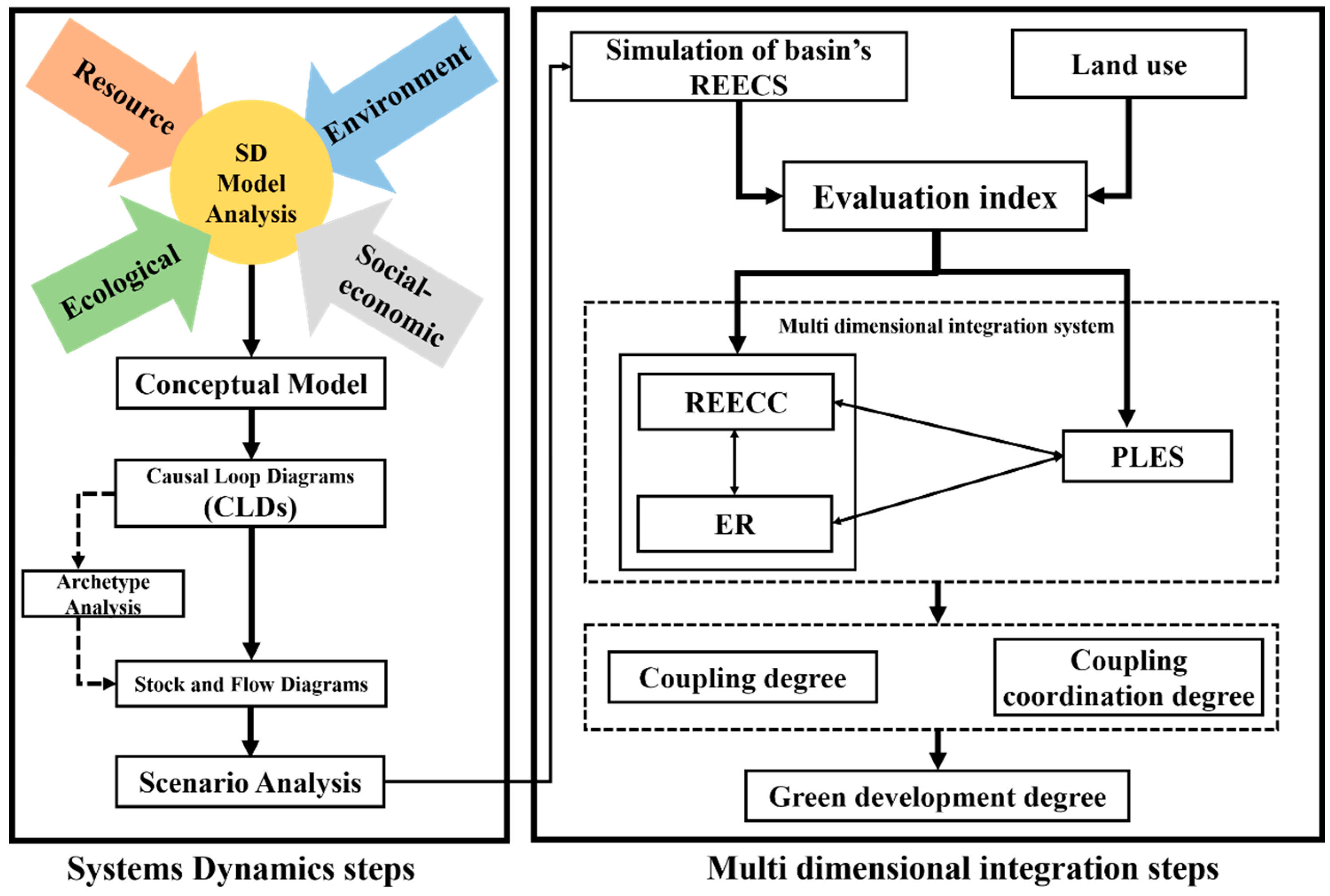
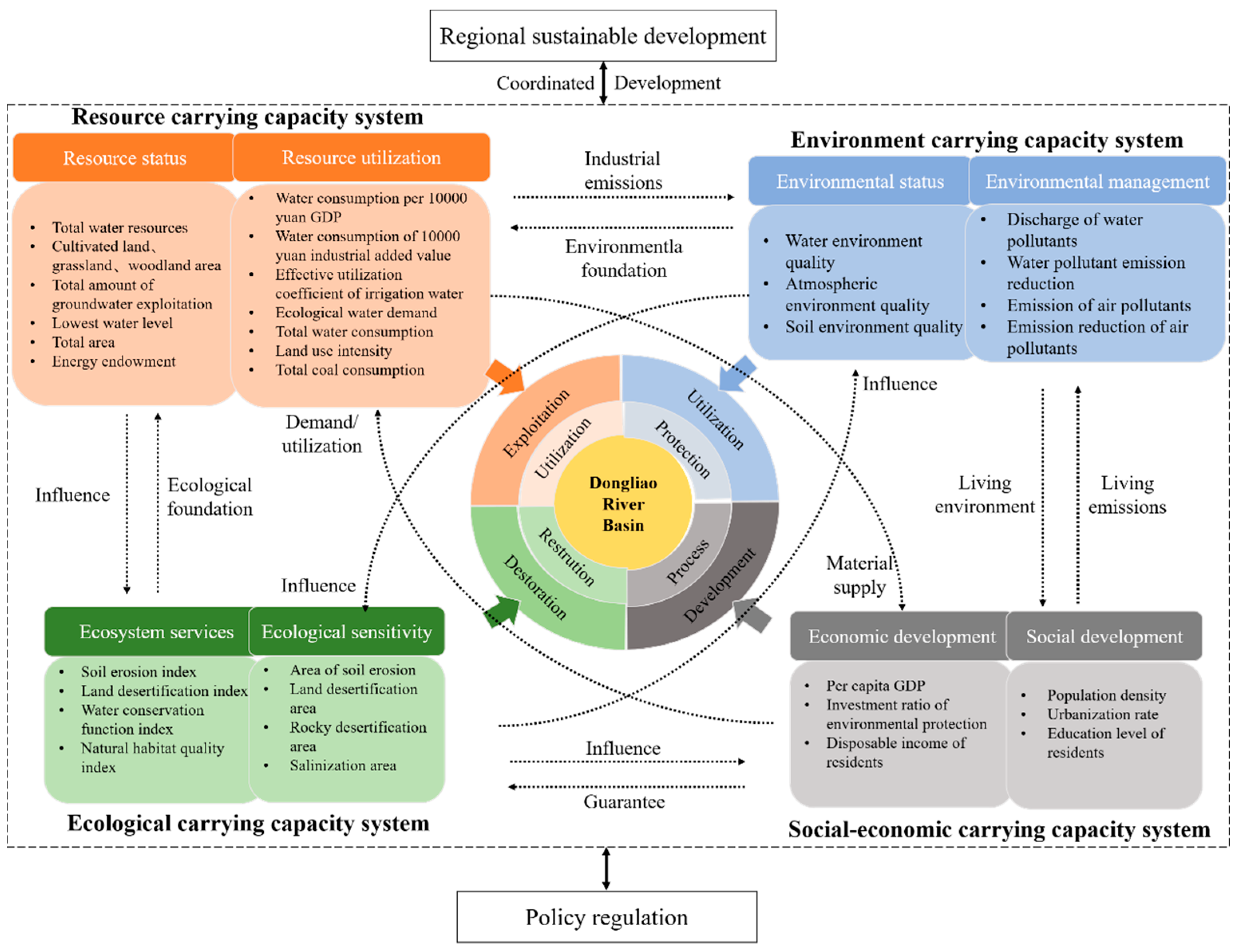
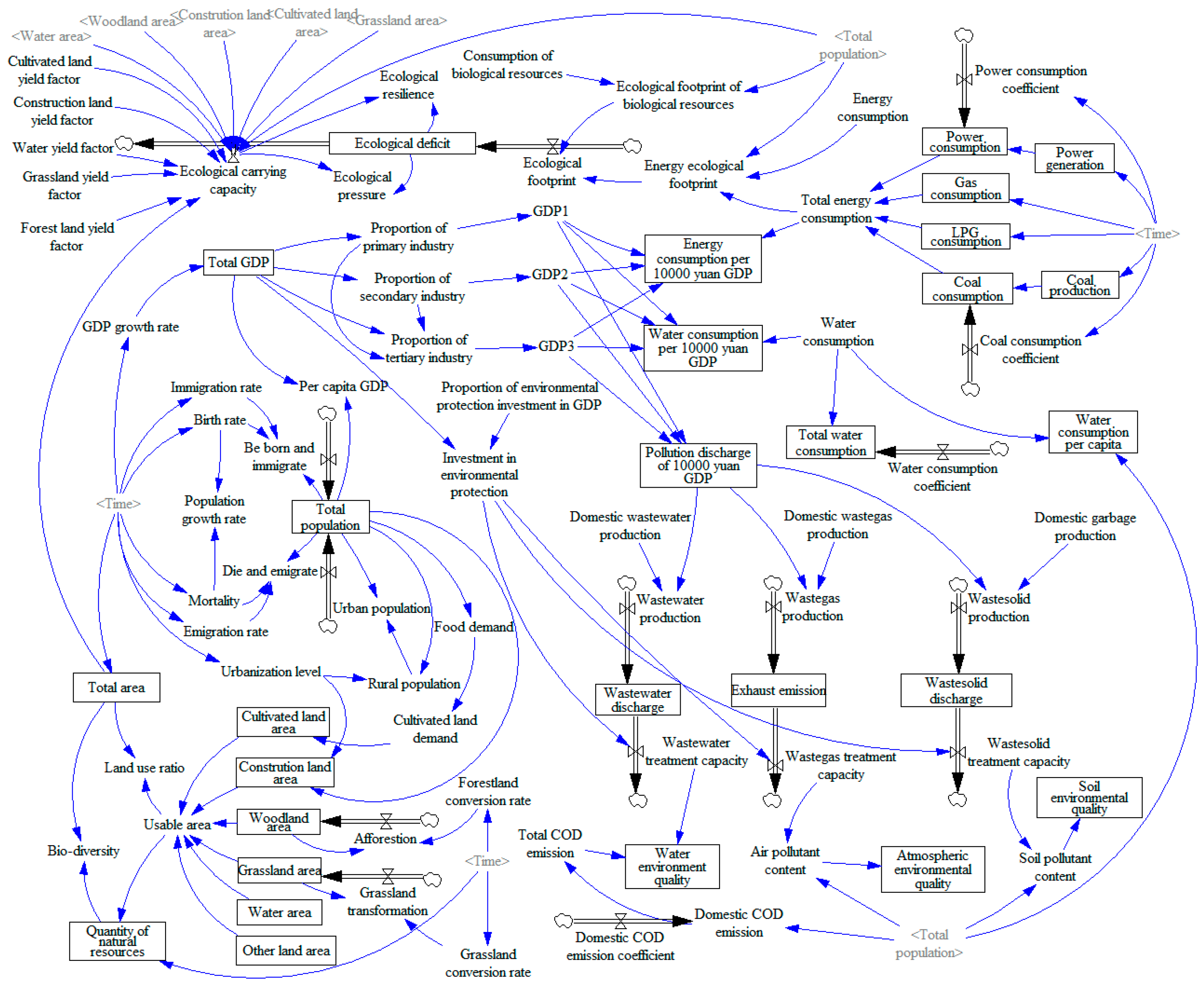

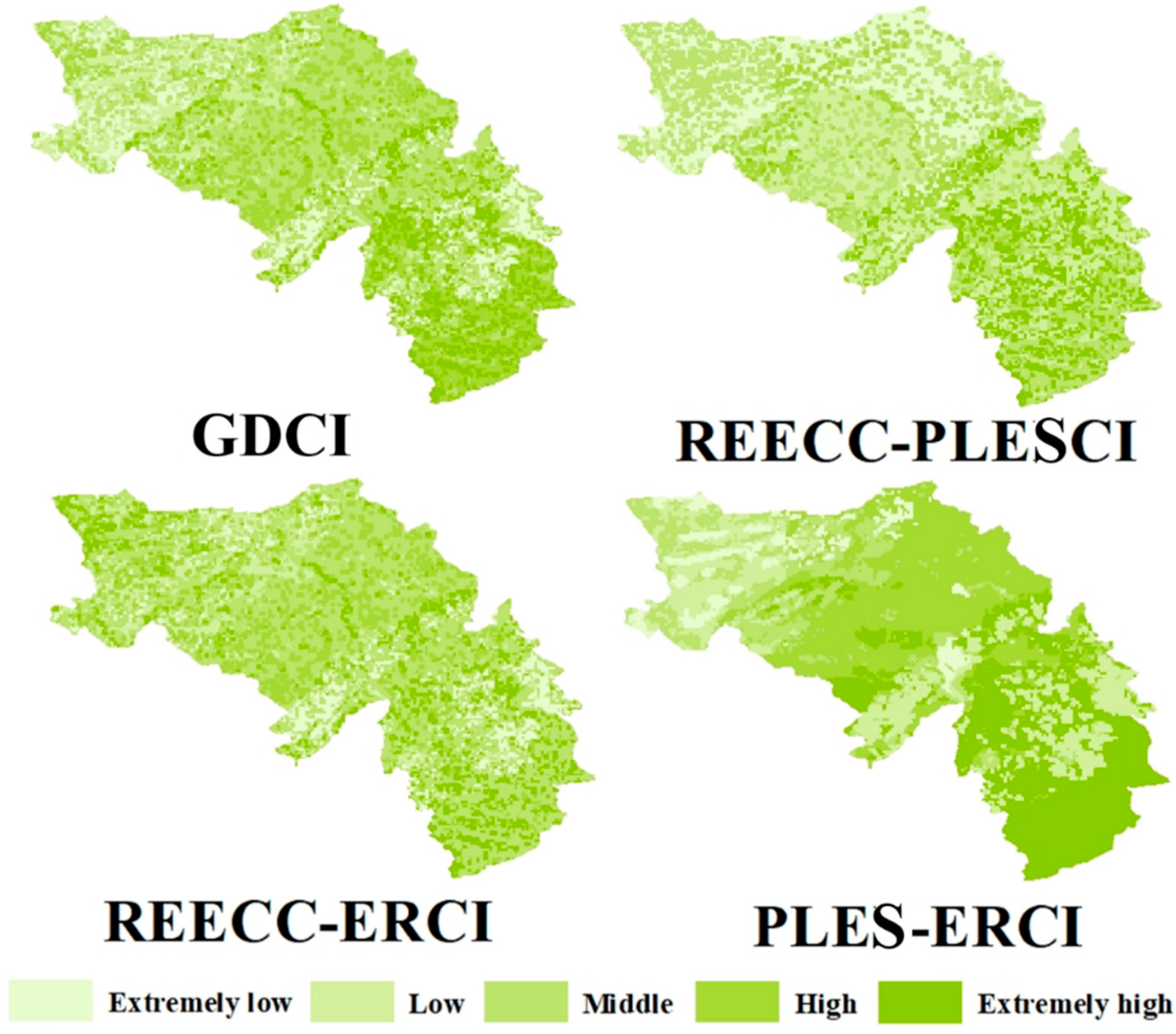
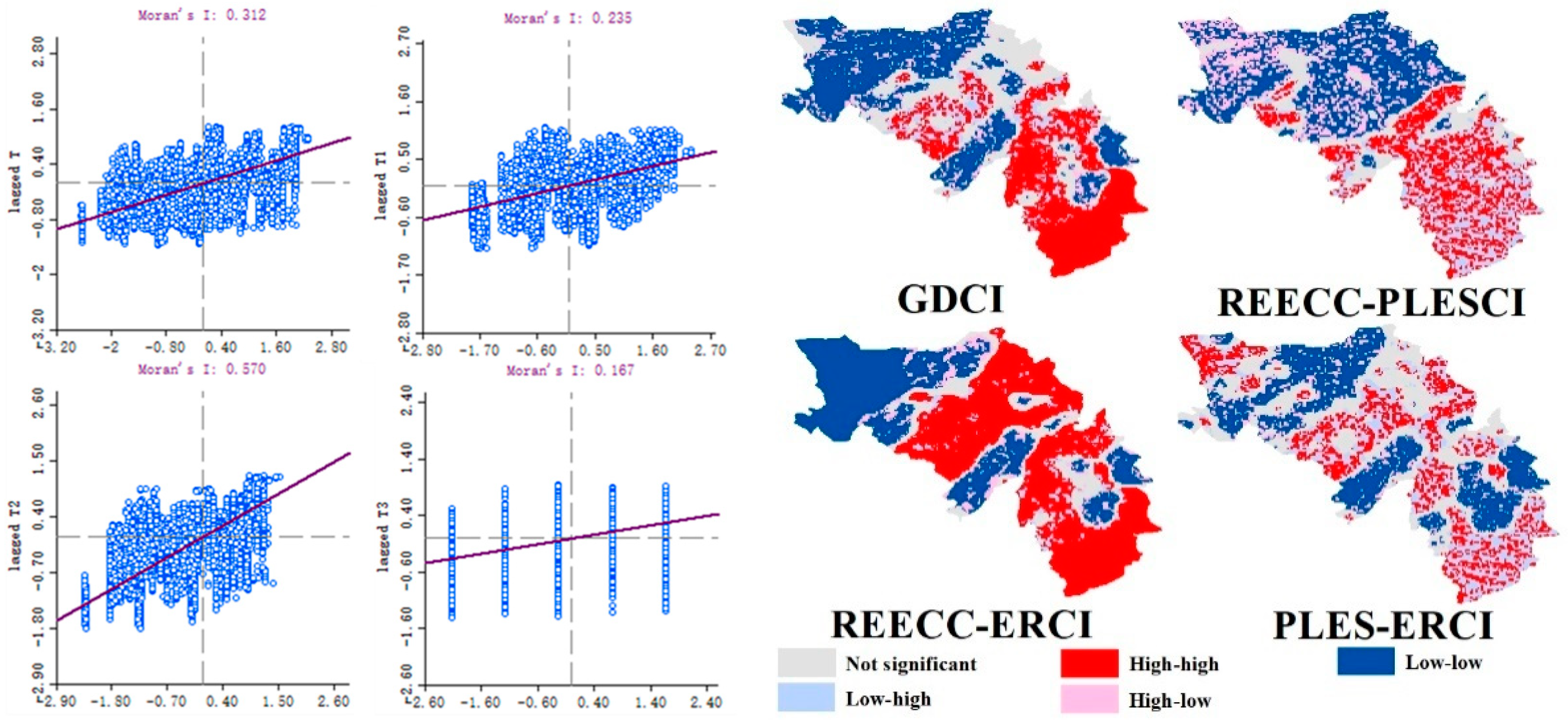


| Object Hierarchy | Criteria Layer | Indicators | Serial Number | Weight | Attributes |
|---|---|---|---|---|---|
| REECC in DBS | State B1 | Ecological environment quality index | C1 | 0.2249 | + |
| Air pollution index | C2 | 0.4035 | - | ||
| Water quality index | C3 | 0.2470 | - | ||
| Total ecological redline index | C4 | 0.1246 | - | ||
| Pressure B2 | Salinization | C5 | 0.0809 | - | |
| Desertification of land | C6 | 0.0911 | - | ||
| Soil erosion | C7 | 0.0886 | - | ||
| Wind prevention and sand fixation | C8 | 0.0867 | - | ||
| Conservation of water and soil | C9 | 0.1218 | - | ||
| Water conservation | C10 | 0.0909 | - | ||
| Response B3 | Sewage discharge | C11 | 0.0819 | - | |
| Sewage treatment capacity | C12 | 0.0704 | + | ||
| Exhaust emissions | C13 | 0.0600 | - | ||
| Nature reserve | C14 | 0.1492 | - |
| Indicators in State Layer | Principal Component | |
|---|---|---|
| PC1 | PC2 | |
| Ecological environment quality index | 0.9248 | −0.2444 |
| Air pollution index | 0.9060 | −0.2514 |
| Water quality index | 0.5546 | 0.3827 |
| Total ecological redline index | 0.2797 | 0.8634 |
Publisher’s Note: MDPI stays neutral with regard to jurisdictional claims in published maps and institutional affiliations. |
© 2021 by the authors. Licensee MDPI, Basel, Switzerland. This article is an open access article distributed under the terms and conditions of the Creative Commons Attribution (CC BY) license (https://creativecommons.org/licenses/by/4.0/).
Share and Cite
Wang, A.; Tong, Z.; Du, W.; Zhang, J.; Liu, X.; Yang, Z. Comprehensive Evaluation of Green Development in Dongliao River Basin from the Integration System of “Multi-Dimensions”. Sustainability 2021, 13, 4785. https://doi.org/10.3390/su13094785
Wang A, Tong Z, Du W, Zhang J, Liu X, Yang Z. Comprehensive Evaluation of Green Development in Dongliao River Basin from the Integration System of “Multi-Dimensions”. Sustainability. 2021; 13(9):4785. https://doi.org/10.3390/su13094785
Chicago/Turabian StyleWang, Aoyang, Zhijun Tong, Walian Du, Jiquan Zhang, Xingpeng Liu, and Zhiyi Yang. 2021. "Comprehensive Evaluation of Green Development in Dongliao River Basin from the Integration System of “Multi-Dimensions”" Sustainability 13, no. 9: 4785. https://doi.org/10.3390/su13094785






